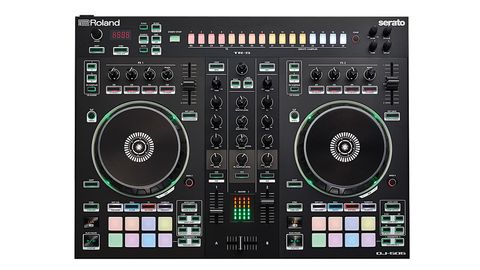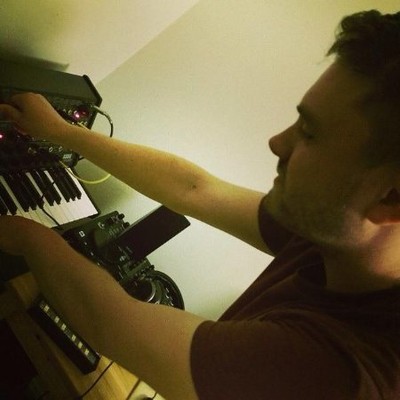Roland first entered the DJ controller market with the DJ-808, a four-channel controller for Serato DJ mixer paired with a TR-8-derived drum machine.
The logic behind bringing these two worlds together is certainly sound - the distinctive beats of the 808 and 909 run through the heart of dance music, and anybody who’s attended a Jeff Mills club set can attest to how well a live drum machine can work a dancefloor. Personally, however, we were always sceptical about the DJ-808 due to its size and price. Controllers aren’t always the best option for touring DJs - particularly in the worlds of house and techno where club setups tend to be built around CDJs or timecode setups. It’s therefore debatable whether having your DJ workflow built around a specific - fairly weighty - controller is preferable to simply buying separate drum machine and DJ devices.
On this front, the DJ-505 seems like a sensible compromise. With a street price a little over half that of the DJ-808, it’s much more affordable, and less cumbersome. You lose some features from that bigger sibling - most notably two mixer channels and the VT vocal processing - but what remains is still a well-equipped DJ controller combined with ACB-powered 909, 808, 707 and 606-emulating drum machine.

As a mid-priced Serato controller, the DJ-505 more than holds its own. Its construction is perhaps not as high-end feeling as some other controllers, but all the rotaries and faders feel robust. The jog wheels feel decent too, with little latency. We’re not a big fan of all the green backlighting, but it’s useful in dark settings.
Setup is simple - install the included copy of Serato DJ Pro and the DJ-505 is pretty much plug-and-play. In terms of control offered, it’s pretty standard fare for a mid-level controller, with eight performance pads and a bank of effect rotaries joining the jogwheels on each deck.
There’s a decent amount of I/O here that makes the DJ-505 fairly expandable too. The mixer itself can work standalone, with inputs for two decks/players on the rear. The controller is Serato DVS-ready too, so can be turned into a hub for a timecode setup with a Serato DVS software upgrade. There’s also a mic-in with gate, high-pass, reverb and delay equipped. The controller packs a MIDI output too, so it can act as a clock source or send out MIDI messages from the 16-step sequencer or performance pads, which is great for triggering external drum machines.
Launched at this year’s NAMM, TR-Sync sees Roland and Serato furthering their partnership by allowing any of the modern TR drum machines to work in sync with Serato DJ Pro. Pleasingly, this is a free update for all existing users, rather than a paid upgrade like Serato DVS, which just involves updating the firmware of your drum machine. In use it’s a pretty simple system - just plug the drum machine into your laptop via USB and connect the audio output to an available mixer channel and you can use the drum machine as an extra deck in DJ Pro.
There are certainly ways Serato and Roland could go further with this - it’d be great to have plug-and-play MIDI control of Serato’s sampler using the drum machine as a controller, say. The simplicity of the current setup is probably no bad thing though. The last thing most DJs want is to add too much complication to their setups, and the ability to easily plug in a drum machine and know that it’ll be locked to your set’s bpm is great.
This kind of setup is particularly fun as a way to add a bit of extra weight to classic funk and soul records. A bit of prep is necessary here, due to the fact that a lot of tracks from this era are built around real, unquantised drum beats. Serato DJ Pro’s movable beat grid markers make this easy enough to set up, by simply making sure the beat maker is placed on the first beat of each bar through the track. With this set up, it can sound great adding some meaty 808 kicks and claps over the top of a classic recording, which can add the extra weight that’s often missing when mixing vintage tracks in with newer productions. Get a little creative with your loop points and drum fills and it’s possible to get edits going on the fly too.
TR-Sync isn’t entirely groundbreaking - sharing a MIDI clock between DJ gear and hardware is nothing new - but it works seamlessly and should be enough to tempt existing TR-using producers into the Serato realm, and vice-versa.
The real selling point here is the inclusion of the ‘TR-S’ drum machine, and the DJ-505 delivers well in this regard. The sounds are the same as those in the first gen TR-8 - some of the best emulations you’ll find in modern hardware. Hands-on control of sounds is, naturally, reduced compared to the dedicated ‘TR’ machines, but there’s still a bank of four rotaries to control the level, attack, decay and tuning of each sound. The 16-step buttons allow for classic x0x-style sequencing, with accented steps and a 16-pattern memory available. The sequencer can simultaneously be used with Serato’s sampler too: a nice touch. What’s more, each deck’s performance pads can be used to play the TR-sounds: great for finger drumming. It’s just a shame there’s no MPC/Maschine-style beat repeat. The TR section also gets a global level and cue control in the central mixer.
All in all, we really do like the 505. It’s a little visually garish, but given its compact size and affordable price, it’d make a good studio addition for bedroom producers who are looking for both a DJ scratch pad and a hardware drum machine.


